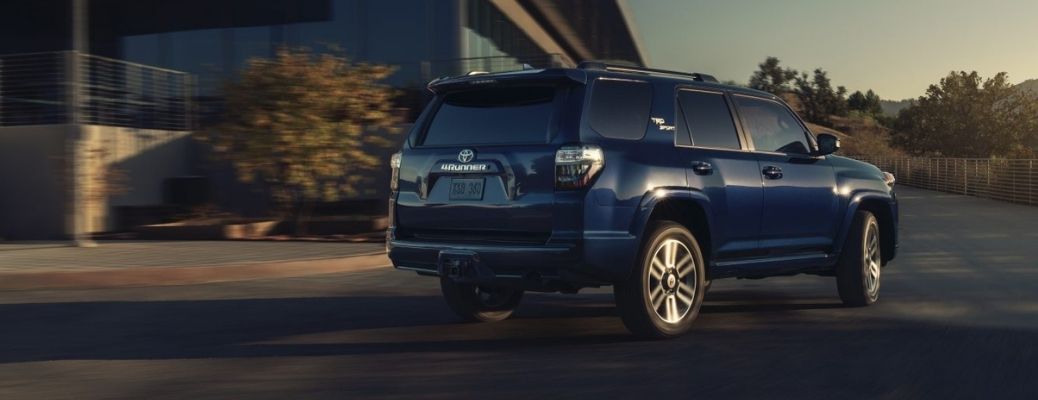Navigating The Road With Confidence: A Comprehensive Look At Toyota 4Runner Safety Features
Navigating the Road with Confidence: A Comprehensive Look at Toyota 4Runner Safety Features
Related Articles: Navigating the Road with Confidence: A Comprehensive Look at Toyota 4Runner Safety Features
Introduction
With enthusiasm, let’s navigate through the intriguing topic related to Navigating the Road with Confidence: A Comprehensive Look at Toyota 4Runner Safety Features. Let’s weave interesting information and offer fresh perspectives to the readers.
Table of Content
Navigating the Road with Confidence: A Comprehensive Look at Toyota 4Runner Safety Features

The Toyota 4Runner, renowned for its rugged off-road capabilities and dependable performance, has consistently prioritized driver and passenger safety. While the 4Runner’s robust construction and advanced braking systems are well-established safety features, recent model years have seen the integration of sophisticated driver assistance technologies, significantly enhancing awareness and reducing the risk of accidents. Among these technologies, the Blind Spot Monitoring system stands out as a crucial addition, offering a vital layer of safety on the road.
Understanding the Blind Spot Monitoring System
The Blind Spot Monitoring system utilizes sensors, typically radar or ultrasonic, strategically positioned on the vehicle’s rear bumper or side mirrors. These sensors constantly monitor the area directly behind and to the sides of the vehicle, areas traditionally referred to as "blind spots." These spots are invisible in the rearview mirrors and often remain undetected by the driver, creating a significant risk of collisions during lane changes.
When the system detects a vehicle in the blind spot, it alerts the driver through a visual indicator, usually a small light in the side mirrors. This visual cue, appearing when a vehicle enters the blind spot, serves as a clear warning for the driver to reconsider a lane change. Some advanced systems even incorporate audio alerts, providing a more immediate and direct warning to the driver.
The Importance of Blind Spot Monitoring in the Toyota 4Runner
The Toyota 4Runner, known for its substantial size and high ground clearance, often faces challenges with visibility, particularly during lane changes. The presence of blind spot monitoring significantly mitigates this risk, providing drivers with an extra layer of awareness that can be crucial in preventing accidents.
The system’s benefits are particularly pronounced in high-traffic environments, where lane changes are frequent and the risk of collisions is elevated. Similarly, when driving on highways or busy roads with limited visibility, the blind spot monitoring system can offer a critical safety net, alerting the driver to potential dangers that might otherwise go unnoticed.
Beyond Blind Spot Monitoring: A Deeper Dive into Toyota 4Runner Safety Features
While blind spot monitoring is a significant safety advancement, the Toyota 4Runner offers a comprehensive suite of driver assistance technologies, working in conjunction to enhance safety and peace of mind. These features include:
- Rear Cross-Traffic Alert: This system uses sensors to detect approaching vehicles when reversing, alerting the driver to potential collisions with a visual and/or audio warning. This feature is particularly valuable when exiting parking lots or narrow driveways with limited visibility.
- Lane Departure Alert: This system utilizes cameras or sensors to monitor lane markings and alert the driver if the vehicle begins to drift out of its lane unintentionally. This feature helps to prevent accidents caused by driver fatigue or distraction.
- Adaptive Cruise Control: This system uses sensors to maintain a safe distance from the vehicle ahead, automatically adjusting speed to maintain a predetermined following distance. This feature helps to reduce driver fatigue and improve overall safety, particularly during long drives.
- Automatic Emergency Braking: This system utilizes sensors to detect potential collisions and automatically applies the brakes if necessary, reducing the severity of an impact or preventing the collision altogether. This feature is particularly useful in preventing accidents caused by driver distraction or in situations where reaction time is limited.
FAQs about Blind Spot Monitoring in the Toyota 4Runner
- Does the Blind Spot Monitoring system work in all conditions? The system’s effectiveness can be affected by environmental factors such as heavy rain, snow, or fog. Additionally, the system may not detect small vehicles or objects that are close to the vehicle’s side.
- How can I activate the Blind Spot Monitoring system? The system is typically activated automatically when the vehicle is started. However, some models may offer the option to disable the system through the vehicle’s settings.
- What should I do if the Blind Spot Monitoring system alerts me? If the system alerts you, it is essential to check your mirrors and confirm the presence of a vehicle in the blind spot. Avoid making a lane change until you are confident that it is safe to do so.
- Is the Blind Spot Monitoring system a replacement for checking my mirrors? While the Blind Spot Monitoring system provides an additional layer of safety, it is crucial to continue using your mirrors and checking your blind spots before making any lane changes.
Tips for Using Blind Spot Monitoring Effectively
- Familiarize yourself with the system: Understand how the system works and how it alerts you. Practice using the system in different driving scenarios to develop a sense of its capabilities.
- Maintain a safe following distance: The Blind Spot Monitoring system relies on sensors to detect vehicles in your blind spot. Maintaining a safe following distance allows the system to operate more effectively.
- Be aware of the system’s limitations: Remember that the Blind Spot Monitoring system is not foolproof. It may not detect all vehicles or objects, and its effectiveness can be affected by environmental conditions.
Conclusion
The Toyota 4Runner’s Blind Spot Monitoring system represents a significant advancement in driver safety technology. By providing drivers with an additional layer of awareness, this system helps to mitigate the risk of collisions caused by blind spots. While it is essential to use the system responsibly and in conjunction with other safety practices, the Blind Spot Monitoring system undoubtedly contributes to a safer and more confident driving experience for Toyota 4Runner owners. As technology continues to evolve, the integration of driver assistance features like blind spot monitoring will likely become increasingly prevalent in vehicles, further enhancing safety and driving comfort for all road users.








Closure
Thus, we hope this article has provided valuable insights into Navigating the Road with Confidence: A Comprehensive Look at Toyota 4Runner Safety Features. We thank you for taking the time to read this article. See you in our next article!
You may also like
Recent Posts
- The 2025 Toyota 4Runner: A Legacy Reimagined
- The Enduring Appeal Of The Toyota 4Runner Manual Transmission 4×4
- The Toyota 4Runner TRD Off-Road: A Legacy Of Adventure, Reimagined For 2025
- The Anticipation Builds: Unveiling The Next Generation Toyota 4Runner
- The 2025 Toyota 4Runner TRD: A Legacy Of Adventure Reimagined
- The Future Of Color: Exploring The Significance Of Color Trends
- The Toyota 4Runner: A Legacy Of Capability, Now With Expanded Seating
- The Toyota 4Runner Timing Belt: A Vital Component For Engine Longevity
Leave a Reply